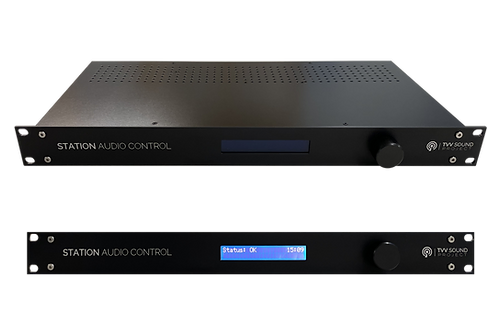Beskrivning
The New Standard for monitoring and surveillance of PA speaker networks.
Do you know if your speaker system really works?
The Station Audio Control® (SAC) is specifically developed for monitoring and surveillance of PA speaker networks, for example on railway station facilities. It enables measuring of audio levels from both the line inputs and amplifier outputs of amplifiers. Deviations from preset values are signaled and reported, e.g. to a server via an SNMP trap.
Additionally, impedances of speaker networks are checked as to whether these are still within the permitted margin. A maximum of 4 speaker networks, plus associated amplifier inputs & outputs, can be connected. The impedance measurement ranges from 2Ω to 5000Ω.
During the installation of the system, a calibration step of the speaker network should be performed. In this step, the impedance of the network is measured and stored as a reference value. At every subsequent measurement of the network, the result is compared with this reference value. A deviation of more than 10% is signaled.
An automatic measurement of the impedance of the network can be done, once a day and at a preset time; preferably at night, as this is when there is the least amount of traffic on the tracks and platforms. Noise affects the outcome of the measurement.
The measurement of the speaker network is not audible.
During the measurement, the speaker network is probed 4 times at intervals of X seconds. The measurement itself takes 1 second. The interval time X is adjustable from 5 to 60 seconds.
If two or more of the 4 values deviate 10% or more from the stored (reference) value, the measurement is repeated. The interval time between repeats is 30 seconds.
The measurement is repeated a maximum of 3 times. If the deviation still exceeds the limit of 10%, a notification is sent and the measurement is stopped.
If the value is far too high (open connection) or far too low (short circuit), the message “TOO HIGH” or “TOO LOW” will appear on the display on completion of the measurement. The web page will show this status with the values “high” or “low”.
A second check done by the device is whether the amplifier is still functioning properly. This proceeds in the following way:
The paging signal is received at line level on an XLR connector. It passes and leaves the device via a loop-through the circuit. This enables the device to detect whether audio is “in-coming”. We follow the same procedure to check the output of the amplifier. It is verified that during a paging message, audio is present on the output of the amplifier. If not, a notification is sent. Similarly, if the output level of the amplifier deviates from the calibrated value, a message will appear.
In order to log all notifications at the correct time, the internal clock of the SAC must be synchronized on start-up, preferably to the network time server. Thus, all devices will run in sync.
The internal clock of the SAC continues to run for several weeks, if the device is non powered.
The status and audio levels of the four sources can be read on the device display. It also offers a menu, for adjusting settings.
Furthermore, you can log into the device with a web browser to configure the system via five web pages.
The core software of the SAC is Linux. A drawback of this OS is that in the event of a power loss, the latest status messages and notifications are not yet written into the logs. To prevent this, a battery has been placed in the SAC that ensures that in the event of a power failure, the OS is properly shut down and (cached) data is saved. The battery is of Lithium-Metal type and it has an expected lifespan of 8 to 10 years. If the battery voltage drops below a limit, this is signaled via SNMP and in the log.
Since the SAC is solid-state (no fan), it is virtually maintenance free.



